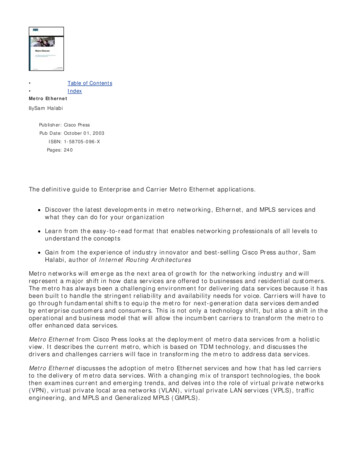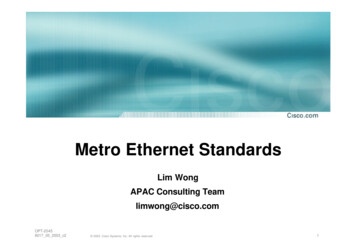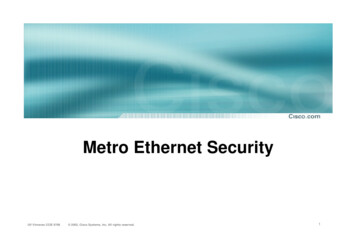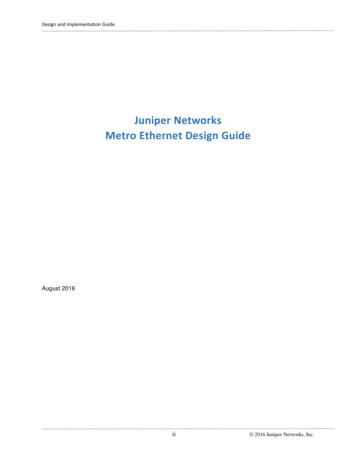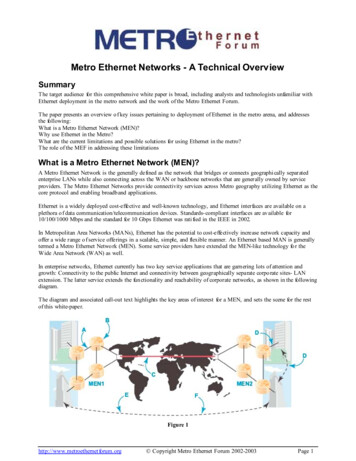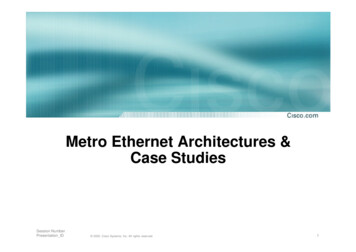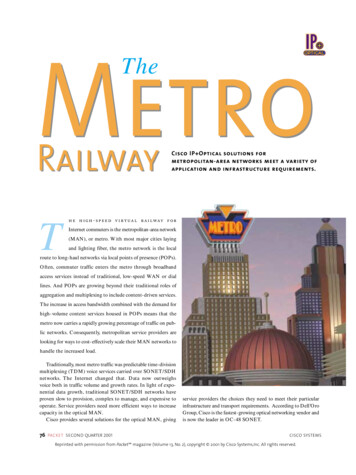
Transcription
10E Metro.txxp4/24/0107:30 AMPage 76TheMetroRailwayTCisco IP Optical solutions formetropolitan-area networks meet a variety ofapplication and infrastructure requirements. - Internet commuters is the metropolitan-area network(MAN), or metro. With most major cities layingand lighting fiber, the metro network is the localroute to long-haul networks via local points of presence (POPs).Often, commuter traffic enters the metro through broadbandaccess services instead of traditional, low-speed WAN or diallines. And POPs are growing beyond their traditional roles ofaggregation and multiplexing to include content-driven services.The increase in access bandwidth combined with the demand forhigh-volume content services housed in POPs means that themetro now carries a rapidly growing percentage of traffic on public networks. Consequently, metropolitan service providers arelooking for ways to cost-effectively scale their MAN networks tohandle the increased load.Traditionally, most metro traffic was predictable time-divisionmultiplexing (TDM) voice services carried over SONET/SDHnetworks. The Internet changed that. Data now outweighsvoice both in traffic volume and growth rates. In light of exponential data growth, traditional SONET/SDH networks haveproven slow to provision, complex to manage, and expensive tooperate. Service providers need more efficient ways to increasecapacity in the optical MAN.Cisco provides several solutions for the optical MAN, giving76PACKET SECOND QUARTER 2001service providers the choices they need to meet their particularinfrastructure and transport requirements. According to Dell’OroGroup, Cisco is the fastest-growing optical networking vendor andis now the leader in OC-48 SONET.CISCO SYSTEMSReprinted with permission from Packet magazine (Volume 13, No. 2), copyright 2001 by Cisco Systems,Inc. All rights reserved.
10E Metro.txxp4/24/0107:30 AMPage 77Ethernet has emerged as a popular broadband access technology,so Cisco enables direct Ethernet connections to SONET/SDH,Dynamic Packet Transport (DPT), and dense wavelength-divisionmultiplexing (DWDM) networks. In areas with existingSONET/SDH metro networks or to carry integrated data, voice,and video traffic, Cisco “supercharged” SONET/SDH solutionslower costs and increase service velocity. In places where theInternet is prevalent, Cisco DPT solutions provide direct IP-overfiber connections using Spatial ReuseProtocol (SRP). Where fiber exhaust isimminent, Cisco offers DWDM solutionsoptimized and priced for the metro toincrease fiber capacity.e’re ableSigma Networks, based in San Jose, California is delivering massive metro network capacity to its carrier customers in majormetropolitan areas of the United States. The metro network is basedon the multiservice flexibility of the Cisco ONS 15454 OpticalTransport Platform and the DWDM capacity of the Cisco 15200series DWDM system. “We have been told that our approach israther unique in the architecture we’ve chosen to achieve very rapidturnup times with very high speed bandwidth. Like all startups, welike to think outside the box. Our challengesare somewhat unique. We found Cisco verywilling to work with us to produce a hybridsolution that is optimal for our needs,” saysBill Euske, chief technology officer atto achieveSigma. “An access switch is importantvery rapid turnup times withEthernet as Broadbandbecause it must connect anything to anyAn emerging trend in broadband accessthing as opposed to having a rigid hierarchy.very high-speed bandwidth.service is Ethernet to the metro ring.The Cisco ONS 15454 embodies all theEthernet is relatively inexpensive and enterforward-looking elements that a SONET—BI LL EUSKE, CTO, SIGM A N ETWORKSprise customers understand it. Cisco enablesservice needs. We can use it in ways thatseamless Ethernet-to-optical connectivityprovide up to double the capacity—portsthrough many of its IP Optical platforms,and aggregate speed—of similar add/dropsuch as the new Cisco 7600 Optical Services Router (OSR), the multiplexers. It’s non-hierarchical, which makes it flexible for ourCisco 12000 series Internet router, the Cisco ONS 15454 Optical changing needs as we go forward. The Cisco ONS 15454 can beTransport Platform, the Cisco ONS 15327 Metro Edge Optical configured to support two trunk rings. Typical products on the marTransport, and the Cisco Metro 1500 series.ket in the add/drop SONET technology can only support one ringbecause they have hierarchy.”Supercharged Metro Optical TransportThe supercharged flexibility of the Cisco ONS 15454 platformOne of the reasons that traditional SONET/SDH networks are dramatically reduces the number of boxes in the network, whichslow to provision and expensive to manage is the number of boxes speeds service velocity and lowers operational expenses, both keyrequired, one for each type of interface or multiplex step. To trans- requirements for transporting IP packets. Along with a full crossmit a DS1 signal up to an OC-48 ring requires a minimum of four connect capability, integrated packet switching, statistical multiboxes. Upgrading a SONET/SDH ring to a higher speed requires plexing, and a small footprint, the Cisco ONS 15454 platform meansan entirely new set of boxes with the higher-speed interface. big savings for service providers. A Cisco study indicates that deployFurther, traditional SONET/SDH rings must dedicate half the ment costs of a Cisco ONS 15454 solution saves approximately 83backbone bandwidth to traffic protection, thus strangling precious percent over traditional add-drop multiplexers (ADMs). The studycapacity. “In an Internet-speed economy requiring rapid response to also demonstrates that operational costs of a Cisco ONS 15454 netchanging requirements, the tedium of such old-world methods work are about one-fifth the cost of a traditional ADM network.impairs service velocity and harms competitive advantage,” saysBecause the metro environment is extremely competitive, serviceChristopher Vallee, product marketing manager in the Optical providers must weigh the need for local market presence, or footTransport Business Unit at Cisco.print, with the costs of establishing the network. Although the ONSData networks have long enjoyed the benefits of modular com- 15454 is a cost-effective box compared to other offerings, it is whenponents and interfaces for rapid upgrades, and that paradigm service providers begin weighing the additional enhancements andentered the SONET world with the introduction of the Cisco feature offerings of the ONS 15454 that its real advantages win theONS 15454 Optical Transport Platform. Its modular chassis sup- day. “By decreasing the cost-to-market proposition,” says Vallee,ports a wide variety of interfaces, delivering supercharged SONET “service providers find they can enter markets that they had previtransport by supporting any optical-carrier line rate, integrated opti- ously thought they'd have to wait to grow.”cal networking such as DWDM and ITU wavelengths, andWith the introduction of the Cisco ONS 15327 Metrounprecedented service flexibility with Ethernet, TDM, and Edge Optical Transport Platform, Cisco makes superchargedATM interfaces.SONET networks even more cost-effective. The new platformoffers the same benefits as the Cisco ONS 15454 platform butin a smaller size optimized for metro edge applications. “AndWritten by Gail Meredith (gmeredit@sonic.net), a contributing editor forPacket magazine.where traditional SONET services take weeks or even months“W”CISCO SYSTEMSSECOND QUARTER 2001 PACKETReprinted with permission from Packet magazine (Volume 13, No. 2), copyright 2001 by Cisco Systems,Inc. All rights reserved.77
10E Metro.txxp4/24/0107:30 AMPage 78SUPERCHARGED METRO OPTICAL TRANSPORTWireless AccessCiscoRouterCiscoRouterCiscoRouterCisco ONS15454DS3DS1CiscoONS 15327DS1CiscoONS15454CiscoONS15454CiscoONS 15454OC-12/48MultiunitBuildingOC-12/48OC-48/192 DWDMCiscoONS 15327Cisco SingleUnitMultiunitMultiunitCiscoRoutersPBXFIGURE 1: Cisco’s supercharged metro optical transport solutions enable unprecedented service flexibility for the metropolitan-area network. Consolidating multiple interfaces into fewer boxes such as the Cisco ONS 15454 Optical Transport Platform and Cisco ONS 15327 Metro Edge Optical Transport Platform streamlinesthe architecture to lower deployment and operations costs.to turn up, providers can install the CiscoONS 15327 and turn up service in as little as 20 minutes,” says Vallee.Cisco ONS 15327 platforms can gathertraffic from enterprise customers viarouters, switches, or wireless towers andpass them to the primary transport ringcomprised of Cisco ONS 15454 for multiplexing into TDM or IP data servicePOPs (Figure 1).The Cisco ONS 15454 platform nowsupports SDH interfaces to appeal to service providers outside the US. The CiscoONS 15327 platform initially supportsSONET interfaces, but will have SDHinterfaces available in the near future. The78PACKET SECOND QUARTER 2001entire supercharged metro optical transportsolution is managed via Cisco TransportManager (CTM).Dynamic Packet TransportIn IP-centric environments, an alternative toSONET/SDH infrastructures is DPT. Adirect IP-over-optical technology, DPTallows service providers to build transportnetworks on fiber rings without the use ofATM or SONET/SDH technologies forprotection or switching. DPT enables serviceproviders to build next-generation, packetbased metro networks that deliver scalableInternet services, reliable IP-aware opticaltransport, and simplified network operations.As a data-optimized, IP Optical technology, DPT is ideal for Internet applications. DPT is at home in service POPs andInternet data centers where IP is prevalent,but is also a key component for buildingnext-generation, packet-based MANs.“With DPT, we can extend the benefits ofthe Internet into the metro,” says Jeff Baher,senior manager in the Metropolitan IPAccess Business Unit at Cisco. “It enables anentirely new architecture that eliminatestoday’s metro bottleneck. DPT deliversscalable, cost-effective IP services withoutcompromising reliability.”The foundation of DPT is SRP, aMedia Access Control (MAC) layer protoCISCO SYSTEMSReprinted with permission from Packet magazine (Volume 13, No. 2), copyright 2001 by Cisco Systems,Inc. All rights reserved.
10E Metro.txxp4/24/0107:30 AMPage 79col that operates over a dual-ring topology.It marries the intelligence and scalability ofIP with the bandwidth capacity of optics. Itenables scalable bandwidth and node numbers along with ring survivability features.As a media-independent protocol, SRPcan be deployed over a wide array of underlying physical layer technologies, includingDWDM, SONET/SDH, and dark fiber.An SRP architecture consists of twocounter-rotating fiber rings concurrentlysupporting data and control packets. Unliketraditional, voice-era SONET/SDH rings,which require 50 percent dedicated bandwidth for protection, SRP utilizes all available bandwidth in both rings. A key featureof the SRP protocol is intelligent protectionswitching (IPS), which provides protectionsimilar to automatic protection switching(APS) for SONET/SDH rings. IPS enables50-ms IP service restoration without routing protocol reconvergence.Cisco’s high-end 12000 series Internetrouters (including the new 12410 and12416) support DPT at OC-12/STM-4and OC-48/STM-16 speeds, and Cisco7500 and 7200 series routers supportOC-12/STM-4 DPT interfaces.The complementary Cisco ONS 15190IP Transport Concentrator also providesDPT connectivity at OC-12/STM-4 andOC-48/STM-16 speeds. The concentratorenhances the reliability of DPT networkswith features such as enhanced intelligentprotection switching (E-IPS). Opticalpower monitoring and sophisticated nodemanagement features further reduce operational complexities and simplify networkmanagement.Eastern Multimedia Group (EMG) is acable television and next-generationtelecommunications provider in Taiwan.Its network uses the Cisco 12000 Internetrouter platform and DPT instead of ATM.“The cross operation between cable television and telecommunications has madetelecommunications services-on-cable oneof the biggest opportunities in the ITindustry,” says Chen Quan-Yih, generalmanager of EMG. “More than 70 percentof the households in Taiwan use cable television service. Because our existing ATMCISCO SYSTEMSnetwork architecture hasn’t been able tomeet the needs of the new telecommunications era, EMG has purchased Cisco’s carrier-class, high-end routers and switches todeploy Cisco’s DPT ring architecture toenhance the overall backbone bandwidth.“The cross operationbetween cable televisionand telecommunicationshas made telecommunications services-on-cableone of the biggest opportu-”nities in the IT industry.—CH EN QUAN-YI H, GEN ER AL M ANAGEREASTERN MU LTIMEDIA GROU P, TAIWANCombining Cisco’s technologies withEMG’s existing broadband network architecture and competitive advantages in television broadcasting, and print and onlinemedia, we will be able to provide high-quality, cost-effective networks and carrier-classbroadband services.”DWDM in the MetroWith the rapid increase in metropolitanarea traffic volumes, there is a threat of fiberexhaust in many areas. Rather than dig andlay more fiber at considerable expense, service providers can deploy DWDM in themetro. DWDM exponentially increasestransport capacity by enabling simultaneoustransmission of several signals in a singlefiber, all at different wavelengths.DWDM is familiar to long-haul opticalcores, but until recently has been tooexpensive for metro deployments. Ciscooffers innovative DWDM solutionsdesigned and priced specifically for themetro network, along with short-reachoptical interfaces for its DWDM, DPT,and supercharged metro optical transportplatforms.“Wavelength-division multiplexing isflexible because it’s compatible with anyhigher-layer technology s
direct IP-over-optical technology, DPT allows service providers to build transport networks on fiber rings without the use of ATM or SONET/SDH technologies for protection or switching.DPT enables service providers to build next-generation, packet-based metro networks that deliver scalable Internet services, reliable IP-aware optical
